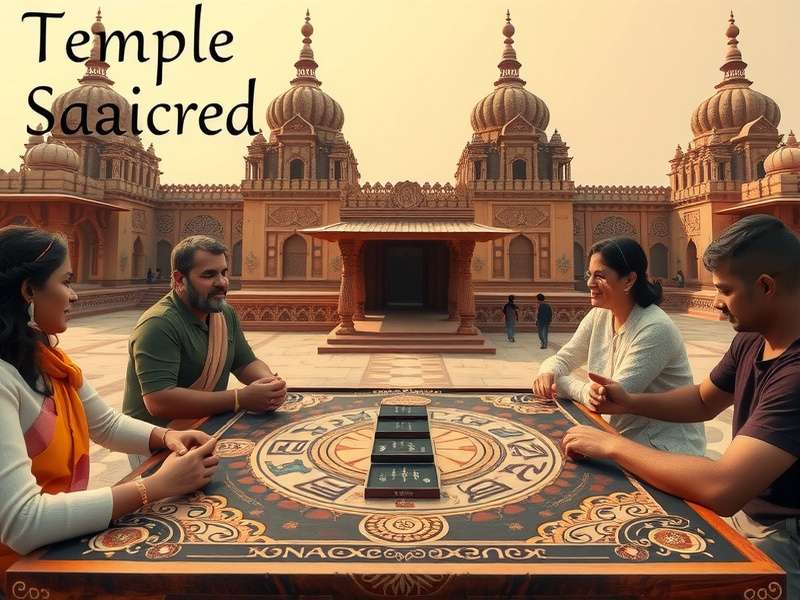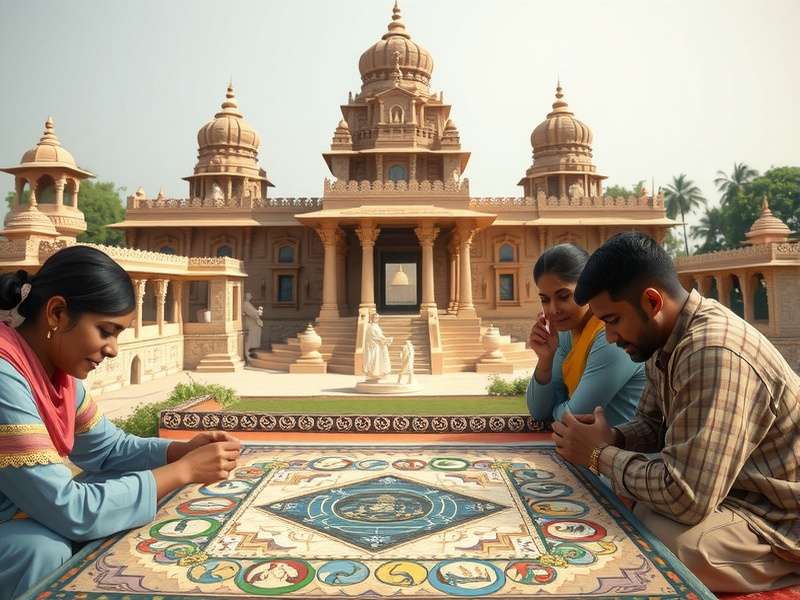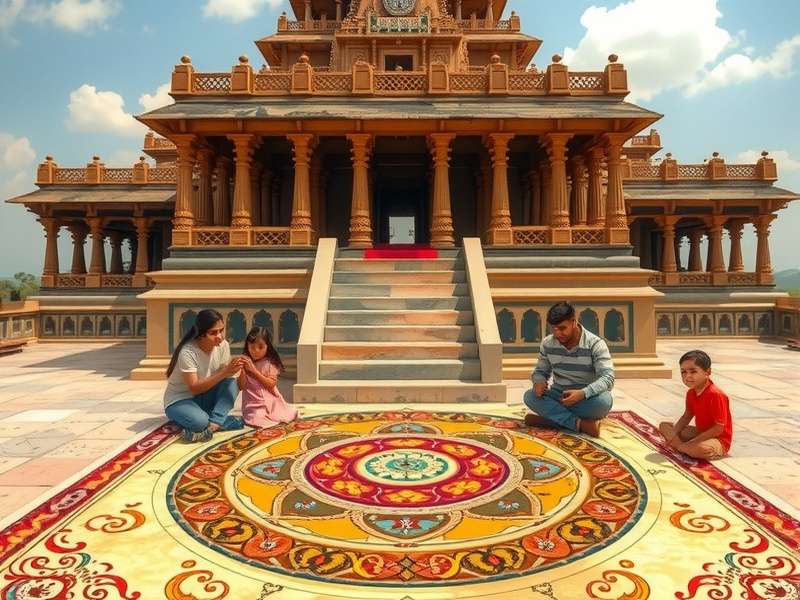Temple Sacred Sojourn: The Spiritual Gaming Experience 🛕
Exploring India's Ancient Tradition of Mythological Strategy Games
Table of Contents
Overview & Origins 🌅
Temple Sacred Sojournrepresents one of India's most profound contributions to the world of traditional gaming. This ancient spiritual pastime combines elements of strategy, mythology, and religious symbolism in a unique blend that has captivated players for centuries.
The game originated in the temple complexes of Southern India during the Chola dynasty, where it served both as entertainment and spiritual instruction. Unlike Western board games focused on competition,Temple Sacred Sojournemphasizes harmony, balance, and the journey toward enlightenment.

What setsTemple Sacred Sojournapart from other traditional games is its deeply integrated philosophical framework. Each move in the game corresponds to a step in the spiritual journey, with players navigating challenges that mirror life's obstacles and opportunities for growth.
The game board itself is a symbolic representation of the cosmos, with concentric circles representing different realms of existence and pathways symbolizing the various paths to enlightenment. This intricate design reflects the sophisticated cosmological understanding of ancient Indian scholars.
Historical Development 📜
The earliest references to what would becomeTemple Sacred Sojournappear in Sanskrit texts dating back to the 8th century CE. These manuscripts describe a game called "Devalaya Yatra" (Temple Journey) played by priests and royalty alike.
During the medieval period, the game evolved significantly, incorporating elements from various philosophical schools including Advaita Vedanta and Buddhist thought. This period saw the standardization of rules and the development of regional variations that reflected local cultural traditions.
Ancient Manuscripts
Documented in 8th century Sanskrit texts with detailed commentaries
Temple Origins
Developed within South Indian temple complexes as spiritual training
The golden age ofTemple Sacred Sojournoccurred during the Vijayanagara Empire (14th-16th centuries), when the game spread throughout the Indian subcontinent and beyond to Southeast Asia. Royal patronage ensured the preservation and refinement of the game during this period.
Colonial era documentation provides valuable insights into howTemple Sacred Sojournwas played before modern influences. British administrators and scholars recorded detailed descriptions of the game, though often through a colonial lens that misunderstood its spiritual dimensions.
The 20th century saw a revival movement dedicated to preserving traditional Indian games, includingTemple Sacred Sojourn. Cultural organizations worked to document variations of the game from different regions before they were lost to modernization.
Gameplay Mechanics ♟️
At its core,Temple Sacred Sojournis a race game with strategic elements, but its mechanics are deeply intertwined with philosophical concepts. The game is typically played by 2-4 players, each representing a spiritual seeker on the path to enlightenment.
The game board features a spiral path divided into 108 spaces, a sacred number in Hindu and Buddhist traditions. Players move their pieces according to throws of specially marked dice or, in some variations, by drawing lots that determine both movement and spiritual challenges.

What makesTemple Sacred Sojournunique is its dual victory conditions. Players can win by either reaching the center of the board first (symbolizing enlightenment) or by accumulating the most spiritual merit through their decisions during gameplay.
The game includes special spaces that trigger philosophical dilemmas, moral choices, or opportunities for meditation. These elements transform the gameplay from mere movement to a contemplative exercise that encourages self-reflection.
Advanced versions ofTemple Sacred Sojournincorporate cards with verses from sacred texts, mandala-based movement patterns, and cooperative gameplay elements where players must sometimes assist opponents to progress collectively.
Symbolism & Mythology 🕉️
Every aspect ofTemple Sacred Sojournis rich with symbolic meaning drawn from India's diverse mythological traditions. The game board represents the cosmos, with the outer rings symbolizing the material world and the center representing moksha (liberation).
Game pieces often take the form of animals associated with Hindu deities: the lion (Durga), elephant (Ganesha), peacock (Kartikeya), and eagle (Garuda). Each piece moves according to patterns that reflect the qualities of its associated deity.
Cosmic Design
Board layout mirrors Hindu cosmological concepts and spiritual progression
Philosophical Depth
Each game element corresponds to spiritual principles and life lessons
Mythological Integration
Draws from Puranic literature and epic narratives for game scenarios
The numerical elements inTemple Sacred Sojourncarry esoteric significance. The 108 spaces correspond to the 108 beads in a japa mala (prayer beads), while the four directions represent the four purusharthas (human goals): dharma, artha, kama, and moksha.
Mythological narratives are integrated through chance cards that present scenarios from the Ramayana, Mahabharata, and Puranas. Players might encounter Ravana's deception, Hanuman's devotion, or Draupadi's dilemma, with each scenario offering different spiritual lessons.
The ultimate goal of reaching the center inTemple Sacred Sojournsymbolizes overcoming maya (illusion) and achieving self-realization. This journey mirrors the spiritual seeker's path in Advaita Vedanta philosophy, where the individual soul realizes its identity with the universal consciousness.
Cultural Significance 🌍
Temple Sacred Sojournhas played a multifaceted role in Indian culture, serving as entertainment, spiritual instruction, and social bonding. The game was traditionally played during festivals, religious ceremonies, and family gatherings, bridging generational divides.
In many communities, proficiency inTemple Sacred Sojournwas considered a mark of cultural refinement and philosophical understanding. Elders would use the game to impart moral and spiritual values to younger generations in an engaging, interactive manner.

The game also served as a subtle form of religious education, familiarizing players with mythological narratives, philosophical concepts, and ethical dilemmas in a format more accessible than formal scripture study. This made complex spiritual ideas approachable for all ages and educational backgrounds.
Regional variations ofTemple Sacred Sojournreflect local cultural traditions, with different states developing their own interpretations that incorporate regional deities, festivals, and moral frameworks. This diversity demonstrates the game's adaptability and enduring relevance.
In contemporary India,Temple Sacred Sojournhas experienced a resurgence as part of the broader interest in traditional practices and cultural heritage. Schools, cultural organizations, and families are rediscovering the game as an alternative to digital entertainment that promotes reflection and connection.
Modern Interpretations 📱
In recent decades,Temple Sacred Sojournhas undergone various reinterpretations to remain relevant in a changing world. Digital versions have been developed that preserve the game's spiritual essence while making it accessible to global audiences.
Educational adaptations ofTemple Sacred Sojournare being used in schools to teach Indian culture, philosophy, and critical thinking skills. These versions often simplify the rules while retaining the core symbolic elements that give the game its distinctive character.
Therapeutic applications have also emerged, with counselors and spiritual guides using modified versions ofTemple Sacred Sojournas a tool for self-reflection and personal growth. The game's structure naturally lends itself to exploring life choices and values.
Digital Adaptations
Mobile and online versions bringing the game to global audiences
Educational Tools
Classroom versions teaching cultural values and critical thinking
Contemporary artists have created artistic interpretations ofTemple Sacred Sojourngame boards, transforming them into works of art that blend traditional motifs with modern aesthetics. These creations celebrate the game's visual richness while introducing it to new audiences.
The basic framework ofTemple Sacred Sojournhas inspired new games that adapt its spiritual journey concept to different cultural contexts. These innovations demonstrate the versatility of the game's core mechanics and their applicability beyond their original cultural setting.
Legacy & Preservation Efforts 🏛️
The legacy ofTemple Sacred Sojournextends far beyond its role as entertainment. The game represents an important aspect of India's intangible cultural heritage, embodying philosophical wisdom, artistic expression, and social traditions.
Preservation efforts forTemple Sacred Sojournface significant challenges, including the declining number of master players who can teach the game's subtleties, competition from digital entertainment, and the fragmentation of traditional knowledge transmission systems.
Museums and cultural institutions have begun documenting and exhibiting historical versions ofTemple Sacred Sojourn, recognizing its importance as both an artifact and a living tradition. These exhibitions help raise awareness about the game's cultural significance.
Academic research intoTemple Sacred Sojournhas grown in recent years, with scholars from fields including game studies, anthropology, and religious studies examining the game from various perspectives. This research is helping to document variations and contextualize the game within broader cultural frameworks.
Community-based initiatives are perhaps the most promising approach to preservingTemple Sacred Sojourn. Local festivals, intergenerational gameplay events, and school programs are helping to ensure that new generations continue to engage with this unique aspect of Indian cultural heritage.
Looking forward, the challenge for custodians ofTemple Sacred Sojournis to balance preservation with adaptation—maintaining the game's spiritual essence while allowing it to evolve in ways that remain meaningful to contemporary players. This delicate balance will determine whether the game continues to thrive in the centuries to come.
Conclusion 🌟
Temple Sacred Sojournstands as a remarkable example of how games can transcend mere entertainment to become vehicles for cultural transmission, spiritual exploration, and philosophical inquiry. Its enduring appeal across centuries speaks to the depth of its design and the universality of its themes.
As both a historical artifact and a living tradition,Temple Sacred Sojournoffers valuable insights into Indian cultural history while continuing to provide meaningful engagement for modern players. Its unique blend of strategy, symbolism, and spirituality represents a gaming tradition unlike any other in the world.
The ongoing revival of interest inTemple Sacred Sojournsuggests that its journey is far from over. As new generations discover this ancient game, they find in it not just a pastime, but a connection to cultural roots and a framework for contemplating life's deeper questions.